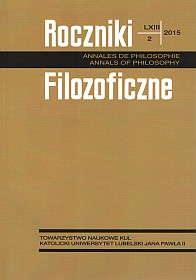The Understanding of Symbols and Their Role in the Ascent of the Soul to God in Pseudo-Dionysius the Areopagite and Nicholas of Cusa
Abstrakt
Niniejszy artykuł podejmuje problem zmian w postrzeganiu symbolu jako istotnego czynnika życia duchowego w łonie filozofii neoplatońskiej. Wydaje się, że to starożytni neoplatonicy pogańscy pierwsi zdali sobie sprawę z tego, jak wielką rolę posiada symbol we wznoszeniu się duszy ku Bogu. Włączyli oni do rozumienia filozofii jako drogi do zjednoczenia z Jednym zaczerpniętą z Wyroczni Chaldejskich i Pism hermetycznych naukę o obrzędach teurgicznych, podczas których używano świętych symboli. Pierwsza część tego artykułu podejmuje próbę ukazania spotkania filozofii z tak pojętym rozumieniem symbolu. Szczególnie ważne dla rozumienia późniejszego pojmowania symboli przez Mikołaja z Kuzy miały używane w najwyższej części rytów teurgicznych symbole matematyczne. Druga część artykułu ukazuje w jaki sposób Pseudo-Dionizy Areopagita przekształca naukę swoich pogańskich poprzedników. Najbardziej istotnym elementem nauki Dionizego jest swego rodzaju wyłączenie symboli z porządku kosmicznego i umieszczenie ich w porządku zbawczym, który gruntuje się na Objawieniu. Prawdziwe symbole dla Pseudo-Dionizego to znaki sakramentalne obecne w liturgii Kościoła. Taka transformacja rozumienia symbolu sprawiła, że symbole matematyczne utraciły swoje wcześniejsze znaczenie. Powyższe analizy umożliwiły ukazanie w ostatniej części niniejszego artykułu kolejnej transformacji rozumienia symbolu, która miała miejsce w filozofii Mikołaja z Kuzy. Piętnastowieczne odrodzenie neoplatonizmu i pitagoreizmu spowodowało powrót do mistycznego traktowania symboli matematycznych, ale jednocześnie zostały one odarte ze rytualnego kontekstu obecnego w starożytnych tekstach.
Bibliografia
Bloom, Paul Richard. Philosophy of Religion in the Renaissance. Farnham: Ashgate, 2010.
Burtt, Edwin A. The Metaphysical Foundations of Modern Science. Mineola: Dover Publications 2003.
Cassirer, Ernst. The individual and the Cosmos in Renaissance Philosophy. Translated by Mario Domandi. Mineola: Dover Publications, 2000.
Dillon, John. “Plotinus and the Chaldean Oracles.” In Platonism in the Late Antiquity, edited by Stephen Gersh and Charles Kannengiesser, 131–140. Notre Dame: University of Notre Dame Press, 1992.
Iamblichus. De mysteriis: translation, introduction and notes by Emma C. Clarke, John M. Dillon, and Jackson P. Hershbell. Atlanta: Society of Biblical Literature, 2003.
Moran, Demot. “Nicholas of Cusa (1401–1464): Platonism at the Dawn of Modernity. In Platonism at the Origins of Modernity. Studies on Platonism and Early Modern Philosophy, edited by Douglas Hedley and Sarah Hutton, 9–29. Dordrecht: Springer, 2008.
Nicholas of Cusa. De docta ignorantia, edited by Ernest Hoffmann and Raymond Klibansky. Leipzig: Meiner, 1932; On Learned Ignorance. Translated by Jasper Hopkins. In Nicholas of Cusa on Learned Ignorance: A Translation and Appraisal of De Docta Ignorantia. Minneapolis: A.J. Benning Press, 1981.
Pseudo-Dionysius. The complete works. Translated by Colm Luibheid, New York: Paulist Press 1987.
Russell, Norman. The Doctrine of Deification in the Greek Patristic Tradition. Oxford: Oxford University Press, 2004.
Shaw, Gregory. Theurgy and the Soul. University Park: Pennsylvania State University Press, 1995.
Wear, Sarah Klitenic, and John M. Dillon. Dionysius the Areopagite and the Neoplatonist Tradition: Despoiling the Hellenes. Aldershot: Ashgate, 2007.
Copyright (c) 2015 Roczniki Filozoficzne

Utwór dostępny jest na licencji Creative Commons Uznanie autorstwa – Użycie niekomercyjne – Bez utworów zależnych 4.0 Międzynarodowe.





